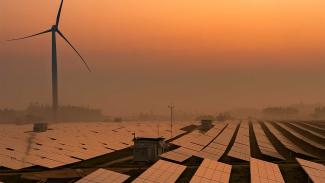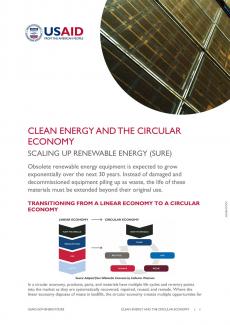Promoting a Circular Economy
Scaling Up Renewable Energy (SURE)
A circular economy for renewable energy can reduce emissions and pressure on natural resources, chart innovative pathways to net-zero economies, create sustainable economic growth and jobs, and reduce supply chain risk
Featured Webinar

Obsolete renewable energy equipment is expected to grow exponentially over the next 30 years. Instead of damaged and decommissioned equipment piling up in landfills, materials’ life must be extended beyond their original intended use. In a circular economy, parts and materials have multiple life cycles and re-entry points into the market as they are systematically recovered, reused, and remade.
According to the International Energy Agency, completely transforming how we produce, transport, and consume energy is imperative to reduce global carbon dioxide emissions to net zero by 2050. Reshaping the renewable energy industry into a more circular economy is a paradigm shift that has significant potential to reduce waste and carbon emissions while extending the supply of parts and materials, including critical metals. It reduces mining which produces quantities of contaminated waste, biodiversity loss, and ecological degradation. Furthermore, a circular economy diversifies the renewable energy industry’s supply of critical metals by directing materials back into the market using environmentally sound practices.
The new paradigm gives rise to a secondary market for repair, refurbishment, and trading of used components and creates sustainable businesses and local jobs for men and women, opportunities desperately needed in economies affected by the global pandemic. New business models focused on reusing, repairing, remanufacturing, and sharing offer significant innovation opportunities. Globally, Accenture Strategy predicts a $4.5 trillion reward for circular economy businesses models by 2030. According to the International Labor Organization, a circular economy could create a net increase of six million jobs by 2030. New jobs will be created in fields such as recycling, services like repair and rental, and in new enterprises that spring up to make innovative use of secondary materials.
USAID Leadership
USAID’s Scaling Up Renewable Energy (SURE) program engages strategically with governments, the private sector, civil society, and communities to support transformational policies and initiatives and build human capital and institutional capacity to address waste challenges while creating economic value and jobs. We work with partners to develop new innovations, sustainable practices, business models, and secondary markets for renewable energy parts and materials, cultivating a circular economy that is gender inclusive, reduces waste, makes the supply chain more resilient, and extends the life of parts.
Partnership Opportunities
A circular economy for renewable energy equipment will result in a more resilient global supply chain for materials while powering economies, creating further use, and redirecting waste away from landfills and back into the market. This nascent approach has the potential to uplift lives, empower women, strengthen communities, and ensure that communities and workers benefit from the transition to a new clean energy economy.
USAID’s SURE program seeks collaborators to reshape the renewable energy ecosystem. If your organization is interested in partnering or co-investing pilot projects with us, contact Sarah Lawson or Kristen Madler.



